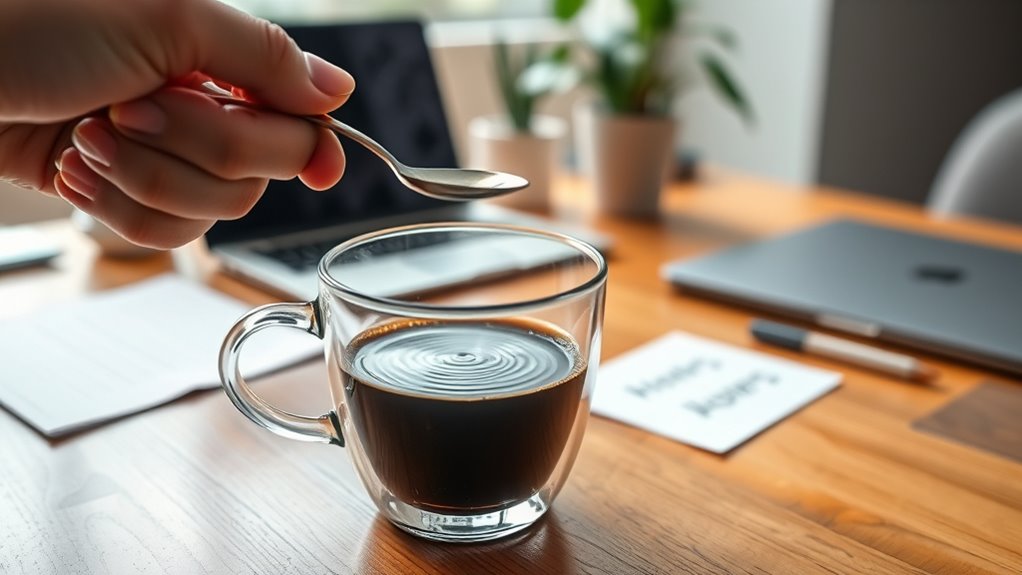To stay alert with small, frequent sips of caffeine, aim for microdoses of about 20 to 50 mg—roughly a quarter to half a cup of coffee. Sip steadily throughout the day to maintain focus without experiencing jitters or crashes. Spreading out your intake helps keep your energy levels stable and consistent. To optimize your approach, consider your metabolism and choose sources with clear mental benefits—more tips await if you continue exploring.
Key Takeaways
- Microdosing involves taking 20-50 mg of caffeine in small, controlled amounts to maintain steady alertness.
- Spreading small sips every few hours prevents energy crashes and sustains focus throughout the day.
- Precise measurement tools help ensure consistent dosing and avoid overconsumption.
- Choosing caffeine sources with favorable contrast ratios enhances mental clarity and minimizes side effects.
- Adjusting intake based on personal metabolic response optimizes alertness and reduces risks of jitters or dependence.

Microdosing caffeine involves taking small, controlled amounts of the stimulant to boost alertness without the jitters or crash often associated with larger doses. This approach allows you to enjoy the benefits of caffeine while minimizing negative side effects. When you microdose, you’re not aiming for the intense jolt that comes with a big cup of coffee; instead, you’re giving your body just enough to stay focused and energized throughout the day. Many people find this method effective because it helps maintain consistent alertness without the spikes and dips that can impair concentration or cause fatigue.
One of the main advantages of microdosing caffeine is its potential health benefits. By sticking to smaller doses, you reduce the risk of experiencing common side effects like anxiety, heart palpitations, or digestive issues. Additionally, moderate caffeine intake has been linked to improved cognitive function and mood, which means you might find yourself more productive and positive. Microdosing can also help you avoid the dependency that sometimes develops with larger doses, allowing you to enjoy caffeine’s benefits without building a tolerance that leads to increased consumption. Moreover, understanding the metabolic processing of caffeine can help optimize your dosing strategy for better results.
Determining the best dosages is key to making microdosing effective. Unlike traditional caffeine consumption, where you might guzzle a large coffee or energy drink, microdosing involves carefully measuring your intake—often in the range of 20 to 50 milligrams per dose. This is roughly equivalent to a quarter to half a cup of coffee, depending on the brew. The goal is to find your personal sweet spot where alertness is boosted, but side effects are minimized. Some people prefer to take small sips throughout the day—every couple of hours—to maintain steady energy levels, rather than consuming all at once. This strategy helps prevent the typical crash associated with larger doses.
In addition, understanding the contrast ratio of your caffeine source can help you select products that provide clearer, more vibrant mental clarity.
Frequently Asked Questions
Can Microdosing Caffeine Cause Long-Term Health Issues?
You’re wondering if microdosing caffeine can cause long-term health issues. While small, frequent sips may seem harmless, the long-term effects and health risks depend on your overall consumption and individual sensitivity. Excessive intake might lead to increased heart rate, anxiety, or sleep problems over time. It’s best to monitor your intake carefully and consult a healthcare professional if you notice any adverse effects to avoid potential health risks.
What Are the Best Types of Caffeine for Microdosing?
Did you know that about 80% of the world’s population consumes caffeine daily? For microdosing, natural sources like green tea or yerba mate are ideal, offering gentle, sustained energy. Alternatively, supplement options like caffeine pills or powders provide precise doses, but choose high-quality, pure products to avoid additives. Both options let you maintain alertness without the jitters, making them perfect for small, frequent sips.
How Does Microdosing Caffeine Affect Sleep Quality?
Microdosing caffeine can help you stay alert, but it may cause sleep disruption if taken too late. Small, frequent sips might reduce the risk of REM suppression compared to larger doses. However, caffeine still affects your sleep quality by delaying sleep onset and reducing REM sleep, especially if consumed in the afternoon or evening. To minimize sleep disruption, consider timing your microdoses earlier in the day.
Is Microdosing Caffeine Safe for Pregnant Women?
Think of pregnancy safety as a delicate dance—you need to be careful with every step. Microdosing caffeine might seem tempting, but it’s best to follow caffeine guidelines during pregnancy. Small, frequent sips won’t guarantee safety, and excess intake could pose risks. Always consult your healthcare provider before considering caffeine, as they can give you personalized advice to keep you and your baby safe and healthy.
How Do Individual Caffeine Sensitivities Impact Microdosing?
Your caffeine sensitivity varies based on genetic factors and how quickly you develop tolerance. If you have a genetic predisposition for high sensitivity, microdosing can help you stay alert without jitters, but you should start with very small amounts. Over time, your tolerance may develop, so you might need to adjust your microdose. Pay attention to how your body reacts to avoid adverse effects and optimize alertness.
Conclusion
As you continue microdosing caffeine, you’ll notice your alertness stabilizing—no crashes, just steady focus. But will this small habit reveal even greater productivity, or could it lead to unexpected side effects? The secret lies in how you fine-tune your intake. Keep experimenting, stay mindful, and watch how your mornings transform. The next breakthrough could be just a sip away—are you ready to discover what’s possible with just a little caffeine?









